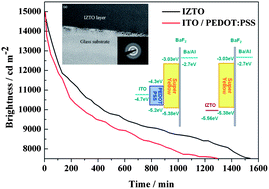Enhanced performance in polymer light emitting diodes using an indium–zinc–tin oxide transparent anode by the controlling of oxygen partial pressure at room temperature†
Abstract
The amount of indium in indium zinc tin oxide (IZTO) was reduced by over 20% by manufacturing an IZTO target containing ZnO for application as the transparent conducting oxide (TCO) anode of polymer light emitting diodes (PLEDs). The IZTO target was manufactured with the composition In2O3 (70 at%)–ZnO (15 at%)–SnO2 (15 at%), and IZTO films were formed at room temperature using a pulsed DC magnetron sputtering system at oxygen partial pressures of 0–4%. The optical and electrical properties of the IZTO films and the device performance of PLEDs with IZTO film were characterized. Amorphous IZTO films prepared at an oxygen partial pressure of 3% showed the best properties. The resistivity, mobility, transmittance, figure of merit and work function of the IZTO film were 5.6 × 10−4 Ω cm, 44.59 cm2 V s−1, 81% (visible region), 3.0 × 10−3 ohm−1, and 5.56 eV, respectively. The PLEDs with the IZTO film deposited under the optimum conditions showed the maximum brightness and the maximum luminance efficiency of 23 485 cd cm−2 and 2.29 cd A−1, respectively, which showed a 21% enhancement in device performance compared to PLEDs with commercial ITO film. In addition, the stability of the fabricated device was improved.


 Please wait while we load your content...
Please wait while we load your content...